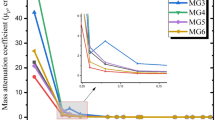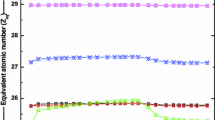Abstract
In this study, the mass attenuation coefficient of boron-containing ores in the Liaoning province of China was calculated using WinXCOM software to investigate the shielding effectiveness of these ores against gamma rays. The mass attenuation coefficients were also calculated using MCNP-4B code and compared with WinXCOM results; consequently, a good consistency between the results of WinXCOM and MCNP-4B was observed. Furthermore, the G-P fitting method was used to evaluate the values of exposure buildup factor (EBF) in the energy range of 0.015–15 MeV up to 40 mean free paths. Among the selected ores, boron-bearing iron concentrate ore (M3) was determined to be the best gamma ray shielding ore owing to its higher values of mass attenuation coefficient and equivalent atomic number and lower value of EBF. Moreover, American Evaluated Nuclear Data File (ENDF/B-VII) was used to analyze the shielding effectiveness against thermal neutrons. It was determined that Szaibelyite (M2) is the best thermal neutron shielding material. This study would be useful for demonstrating the potential of boron-containing ores for applications in the field of nuclear engineering and technology.







Similar content being viewed by others
References
J. An, X.X. Xue, Life cycle environmental impact assessment of borax and boric acid production in China. J. Clean. Prod. 66, 121–127 (2014). https://doi.org/10.1016/j.jclepro.2013.10.020
G. Wang, Q.G. Xue, J.S. Wang, Effect of Na2CO3 on reduction and melting separation of Ludwigite/coal composite pellet and property of boron-rich slag. Trans. Nonferrous Met. Soc. 26, 282–293 (2016). https://doi.org/10.1016/S1003-6326(16)64116-X
G. Wang, Y.G. Ding, J.S. Wang et al., Effect of carbon species on the reduction and melting behavior of boron-bearing iron concentrate/carbon composite pellets. Int. J. Min. Met. Mater. 20, 522–528 (2013). https://doi.org/10.1007/s12613-013-0760-1
X. Ma, H. Ma, X. Jiang et al., Preparation of magnesium hydroxide nanoflowers from boron mud via anti-drop precipitation method. Mater. Res. Bull. 56, 113–118 (2014). https://doi.org/10.1016/j.materresbull.2014.04.021
Z.F. Li, X.X. Xue, T. Jiang et al., Study on the properties of boron containing ores/epoxy composites for slow neutron shielding. Adv. Mater. Res. 201–203, 2767–2771 (2011). https://doi.org/10.4028/www.scientific.net/AMR.201-203.2767
Z.F. Li, X.X. Xue, P.N. Duan et al., Preparation and thermal/fast neutron shielding properties of novel boron containing ore composites. Mater. Sci. Forum 743–744, 613–622 (2013). https://doi.org/10.4028/www.scientific.net/MSF.743-744.613
Z.F. Li, X.X. Xue, S.L. Liu et al., Effects of boron number per unit volume on the shielding properties of composites made with boron ores from China. Nucl. Sci. Tech. 23, 344–348 (2012). https://doi.org/10.13538/j.1001-8042/nst.23.344-348
J.C. Khong, D. Daisenberger, G. Burca et al., Design and characterisation of metallic glassy alloys of high neutron shielding capability. Sci. Rep. 6, 36998 (2016). https://doi.org/10.1038/srep36998
V.P. Singh, N.M. Badiger, γ-ray interaction characteristics for some boron containing materials. Vacuum 113, 24–27 (2015). https://doi.org/10.1016/j.vacuum.2014.11.011
V.P. Singh, N.M. Badiger, N. Chanthima et al., Evaluation of gamma-ray exposure buildup factors and neutron shielding for bismuth borosilicate glasses. Radiat. Phys. Chem. 98, 14–21 (2014). https://doi.org/10.1016/j.radphyschem.2013.12.029
M. Kurudirek, Radiation shielding and effective atomic number studies in different types of shielding concretes, lead base and non-lead base glass systems for total electron interaction: a comparative study. Nucl. Eng. Des. 280, 440–448 (2014). https://doi.org/10.1016/j.nucengdes.2014.09.020
M.I. Sayyed, Bismuth modified shielding properties of zinc boro-tellurite glasses. J. Alloys Compd. 688, 111–117 (2016). https://doi.org/10.1016/j.jallcom.2016.07.153
M.I. Sayyed, S.I. Quashu, Z.Y. Khattari, Radiation shielding competence of newly developed TeO2-WO3 glasses. J. Alloys Compd. (2016). https://doi.org/10.1016/j.jallcom.2016.11.160
M.I. Sayyed, Half value layer, mean free path and exposure buildup factor for tellurite glasses with different oxide compositions. J. Alloys Compd. 695, 3191–3197 (2017). https://doi.org/10.1016/j.jallcom.2016.11.318
M. Kurudirek, D. Sardari, N. Khaledi et al., Investigation of X- and gamma ray photons buildup in some neutron shielding materials using GP fitting approximation. Ann. Nucl. Energy 53, 485–491 (2013). https://doi.org/10.1016/j.anucene.2012.08.002
U. Fano, Gamma-ray attenuation. Part II—analysis of penetration. Minerva Med. 11, 55–61 (1953)
ANSI/ANS-6.4.3, Gamma ray attenuation coefficient and buildup factors for engineering materials (1991)
Y. Harima, Y. Sakamoto, S. Tanka et al., Validity of geometric progression formula in approximating gamma ray buildup factor. Nucl. Sci. Eng. 94, 24–25 (1986)
Y. Harima, An historical review and current status of buildup factor calculations and application. Radiat. Phys. Chem. 41, 631–672 (1993). https://doi.org/10.1016/0969-806X(93)90317-N
M.B. Chadwick, M. Herman, P. Obložinský et al., ENDF/B-VII.1 nuclear data for science and technology: cross sections, covariances, fission product yields and decay data. Nucl. Data Sheets 112, 2887–2996 (2011). https://doi.org/10.1016/j.nds.2011.11.002
G. Ilas, I.C. Gauld, G. Radulescu, Validation of new depletion capabilities and ENDF/B-VII data libraries in Scale. Ann. Nucl. Energy 46, 43–55 (2012). https://doi.org/10.1016/j.anucene.2012.03.012
M.J. Berger, J.H. Hubbell, XCOM: photon cross sections database, Web Version 3.1. http://physics.nist.gov/xcom, National Institute of Standards and Technology, Gaithersburg, MD 20899, USA, 1987/99. Originally published as NBSIR 87-3597 “XCOM: Photon Cross Sections on a Personal Computer”
M.G. Dong, X.X. Xue, H. Yang et al., A novel comprehensive utilization of vanadium slag: as gamma ray shielding material. J. Hazard. Mater. 318, 751–757 (2016). https://doi.org/10.1016/j.jhazmat.2016.06.012
M. Kurudirek, M. Aygun, S.Z. Erzeneoglu, Chemical composition, effective atomic number and electron density study of trommel sieve waste (TSW), Portland cement, lime, pointing and their admixtures with TSW in different proportions. App. Radiat. Isot. 68, 1006–1011 (2010). https://doi.org/10.1016/j.apradiso.2009.12.039
S.M. Kulwinder, S.S. Gurdeep, Verification of some low-Z silicates as gamma-ray shielding materials. Ann. Nucl. Energy 40, 241–252 (2012). https://doi.org/10.1016/j.anucene.2011.09.015
Y. Elmahroug, B. Tellili, C. Souga, Determination of total mass attenuation coefficients, effective atomic numbers and electron densities for different shielding materials. Ann. Nucl. Energy 75, 268–274 (2015). https://doi.org/10.1016/j.anucene.2014.08.015
M.I. Sayyed, H. Elhouichet, Variation of energy absorption and exposure buildup factors with incident photon energy and penetration depth for boro-tellurite (B2O3–TeO2) glasses. Radiat. Phys. Chem. 130, 335–342 (2017). https://doi.org/10.1016/j.radphyschem.2016.09.019
H.S. Chen, W.X. Wang, Y.L. Li et al., The design, microstructure and tensile properties of B4C particulate reinforced 6061Al neutron absorber composites. J. Alloys Compd. 632, 23–29 (2015). https://doi.org/10.1016/j.jallcom.2015.01.048632:23-29
V.F. Sears, Neutron scattering lengths and cross sections. Neutron News. 3, 26–37 (2006). https://doi.org/10.1080/10448639208218770
T. Özdemir, İ.K. Akbay, H. Uzun et al., Neutron shielding of EPDM rubber with boric acid: mechanical, thermal properties and neutron absorption tests. Prog. Nucl. Energy 89, 102–109 (2016). https://doi.org/10.1016/j.pnucene.2016.02.007
Author information
Authors and Affiliations
Corresponding author
Additional information
This work was supported by the National Natural Science Foundation of China (Nos. 51472048, 50774022) and the Key Laboratory Project of Liaoning Province Education Office (No. LZ 2014-022).
Rights and permissions
About this article
Cite this article
Dong, MG., Xue, XX., Singh, V.P. et al. Shielding effectiveness of boron-containing ores in Liaoning province of China against gamma rays and thermal neutrons. NUCL SCI TECH 29, 58 (2018). https://doi.org/10.1007/s41365-018-0397-x
Received:
Revised:
Accepted:
Published:
DOI: https://doi.org/10.1007/s41365-018-0397-x




